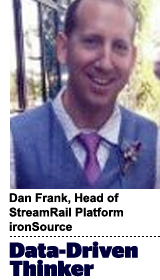 “Data-Driven Thinking” is written by members of the media community and contains fresh ideas on the digital revolution in media.
“Data-Driven Thinking” is written by members of the media community and contains fresh ideas on the digital revolution in media.
Today’s column is written by Dan Frank, head of StreamRail Platform at ironSource.
The digital advertising world has come a long way in the last couple of years in its mission to fight ad fraud. GroupM says just 2% of impressions purchased by the biggest advertisers in Western markets are still fraudulent, compared to the 30% estimated three years ago. That’s remarkable.
But there is still a deeper problem to be solved: the fragmentation of fraud-protection tools.
Since publishers typically look to use the same tools used by their demand traffic, they end up relying on multiple tech providers to measure and combat fraud. That means they could be using White Ops, Integral Ad Science, Forensiq and FraudLogix, to name just a few, simultaneously – not the most efficient process.
In early 2017, a group of viewability vendors banded together in an open-source initiative to help defragment the ecosystem. Integral Ad Science developed an open-source code that lets publishers work with multiple vendors, without having to integrate multiple SDKs. Google, Ansible, Conversant, OpenX, Moat and many others are participating. While this a great first step to greater compatibility among vendors, it doesn’t solve the complete problem since it’s not a measurement standard.
The issue today is that each vendor uses different methodologies and measurement tactics, generating varying results for the same traffic. One anti-fraud provider could inform a particular publisher that 15% of its traffic is fraudulent, while another could turn around and say it’s 8%. How can we confront ad fraud in the industry with such inconsistency?
Time For Standardization
In the past year or so, advertisers, publishers and media agencies have done a better job using accredited third-party verification platforms and measurement solutions to ensure brand safety.
In addition to calling for standardization in viewability and ad metrics, as advertisers have been doing for quite some time, the industry should also be calling for standardization in ad fraud measurement. This way, publishers and advertisers have a single benchmark to assess, identify and act on fraudulent activity.
In order to move forward, anti-fraud providers must sit down, pool their ideas together and define what ad fraud is today. In the years fraud has been on the agenda, providers, publishers, advertisers and agencies have not agreed on what exactly constitutes fraudulent activity.
AdExchanger Daily
Get our editors’ roundup delivered to your inbox every weekday.
Daily Roundup
Of course, we can all agree that nonhuman traffic, like bots, that generate fake impressions and clicks are fraud – as well as click farms, cookie stuffing and site bundling. Furthermore, since sophisticated fraudsters are better at making fraud look like human traffic, it is even more imperative to create clear definitions.
Right now, there are no industry-agreed standards, resulting in varying fraud reports. But this can’t continue: It’s inefficient. The industry, including anti-fraud providers and groups like TAG and the IAB, must define and enforce ad fraud standards for everyone to comply with and bring structure to this gray area.
There are critics in the space who insist standardizing ad fraud measurement defeats competition among providers. But they can still compete over the solutions they offer, despite using the same measurements and definitions. It still takes robust technology to detect ad fraud, especially since fraudsters are becoming increasingly sophisticated, so competition endures.
Current Options
The process of standardizing ad fraud measurement will take time. It’s been years since publishers and advertisers first called for ad metric standardization, and even that project is famously delayed.
In the meantime, publishers and advertisers can blacklist demand sources according to the definitions of suspicious traffic data and analytics used by their technology providers. While this strategy doesn’t solve the standardization problem immediately, it does reduce the need for publishers and advertisers to manually proof each source – a burden for those who use many third-party fraud detection providers. As the same tech providers are used, a unification and understanding of industry needs will become apparent.
It’s the first step in a long journey.
Follow ironSource (@ironSource) and AdExchanger (@adexchanger) on Twitter.












